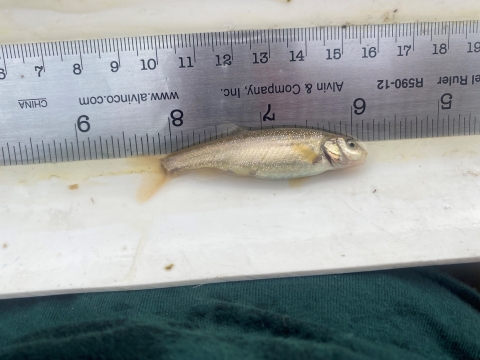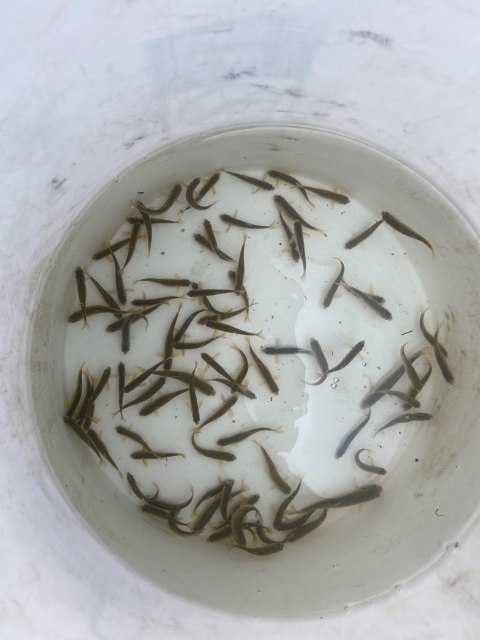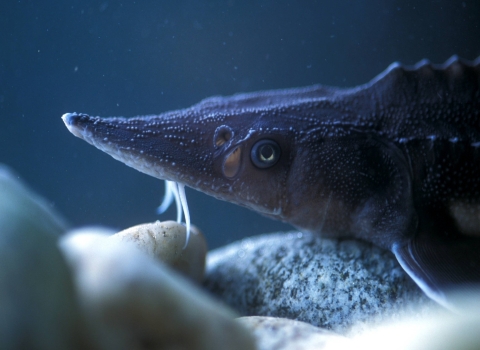Kaylan Hager, a fish and wildlife biologist with the U.S. Fish and Wildlife Service in Reno, Nevada, and Rosa Cox, a fish biologist with the California Department of Fish and Wildlife in Bishop, California, recently sat down with the Fish of the Week! podcast to talk about Long Valley speckled dace and other small desert fishes living at the base of the Eastern Sierra. Read excerpts from that interview below and take a deeper dive into the history of other small desert fish in California’s Owens Valley.
To understand the plight of small fish living in a remote desert, one can first look to the story of Phil Pister, a former district fishery biologist with the Department, who in 1964 made history in the world of small desert fishes.
In the Owens Valley of California, which extends from Bishop, south to the Alabama Hills, Pister and other researchers stumbled upon a clear pool that contained a startling rediscovery, the Owens pupfish; a now federally endangered species of small desert fish that had been presumed extinct since the 1940s.
Five years after this notable rediscovery, to save the only known Owens pupfish population from a drying pond, Pister carried two buckets full of the fish, across hazardous terrain, to a safe location. For a few moments, Pister was responsible for the existence of an entire species. Those moments have continued to inspire recovery efforts for other small desert fish to this day. The Long Valley Speckled Dace is one such fish.
“And we're really just talking about this fish that exists in one small basin and has been isolated from other populations for a significant amount of time.”
Seven hundred and sixty thousand years ago, Long Valley formed near the north end of the Owens Valley as a result of an enormous eruption. The original volcano collapsed in on itself, creating one of the largest calderas in the world. Continued geological movement separated Long Valley from Owens Valley, resulting in an isolated speckled dace population in the local waterways. The resulting isolated speckled dace habitat in Long Valley represents one of the few unique pockets of water found in this arid habitat.
These isolated pockets call to mind another area significant and well known to the history of the life sciences.
“Think of them as similar to the Galapagos Islands, they're islands of water within a very dry system”
Rather than working on the Galapago’s small desert islands, in Long Valley, biologists are working with small water systems across a large desert landscape. These modest rivers and springs exist in a dry expanse and lie in the rain shadow of the more dramatic Sierra Nevada range. Instead of the sails and compasses used by exploratory researchers to study the Galapagos, biologists use four-wheel drive and GPS to identify unique species hiding in the limited desert oases.
“Why do we care what a species is and how it's delineated? … we really, truly care because species are the unit at which we manage…with formal recognition will come… additional ability and resources for conservation and management.”
Extended isolation in Long Valley resulted in a genetically unique population, distinctly different from its nearby neighbor, the Owens speckled dace. The Service received a petition to list the Long Valley speckled dace in 2020 and published a 90-day finding that the petition presented substantial information indicating that the petitioned action may be warranted. As part of the next steps in the review process, the Service will develop a Species Status Assessment to get a clear picture of the biology of the species, what extent it exists on the landscape, and threats to its survival.
Understanding more aboutthe species can help generate greater collaboration between agencies and help find avenues for species recovery efforts.
“The restoration process really does involve just collaborating with agencies, collaborating with partners. [The] U.S. Fish and Wildlife Service has been really critical in helping try to restore habitat and find alternative habitats.”
An example of this collaboration for recovery of small desert fish can be seen in a project for the Owens pupfish. The Department performed an intensive habitat restoration project in 2020 and collaborated with the Service and landowners to introduce the Owens pupfish to the restored water system. This project established an important new population for the imperiled fish species.
While the pupfish has seen some success, the work to restore the Long Valley speckled dace to suitable habitats is in its early stages. Like Pister’s last-ditch effort for Owens pupfish in the 1960s, Steve Parmenter, a former biologist with the Department, likely saved the Long Valley speckled dace by moving some individuals to a private pond in the mid-2000s, said Cox. When the last remaining wild population crashed for unknown reasons, it was this small population on private land that became the source for recovery translocations.
This summer, as part of a planned conservation action in coordination with the Service and the respective landowner, Department staff moved over 400 Long Valley speckled dace to a nearby small stream to establish a new, isolated, population there. These projects and the continued collaboration of multiple partners provide hope for small desert fish in the fight for their existence.
“The main thing that people can do to contribute to conserving native desert fish in general, it's just simply not releasing pet fish into waters”
The introduction of non native species has historically been one of the great challenges to conserving small desert fish. The public can play a part in reducing the harm done to the fish and the habitat where they live by not introducing pet fish, frogs or turtles into wild ponds and water systems.
In addition to preventing the spread of invasive species invasive species
An invasive species is any plant or animal that has spread or been introduced into a new area where they are, or could, cause harm to the environment, economy, or human, animal, or plant health. Their unwelcome presence can destroy ecosystems and cost millions of dollars.
Learn more about invasive species in our native waters, spreading appreciation for the uniqueness of these desert fish can go a long way as well.
“They evolved to fill these niches that another species didn't. So, they're very unique and very rare. And they're there for a reason. And they could be a keystone indicator for that ecosystem…increasing local awareness of all our endemic species in general, could create a group of people who are excited about advocacy.”
There is a long road ahead filled with recovery, management, and further scientific discovery, but that road has been made walkable by former and current passionate biologists and dedicated volunteers.









